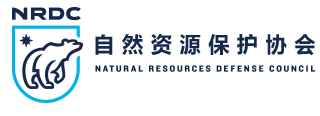编者按: 农业农村部在2021年年底发布的《“十四五“全国渔业发展规划》提出,我国将强化渔业改革创新,实施渔港管理改革,建立基于渔港的渔业综合监管体系。NRDC近期发布报告《渔港监测与渔获物溯源:欧盟经验》,供决策者参考。下文以该报告为基础,简要介绍了欧盟依港管渔体系的关键元素,并对我国“十四五”阶段的相关工作提出了建议。
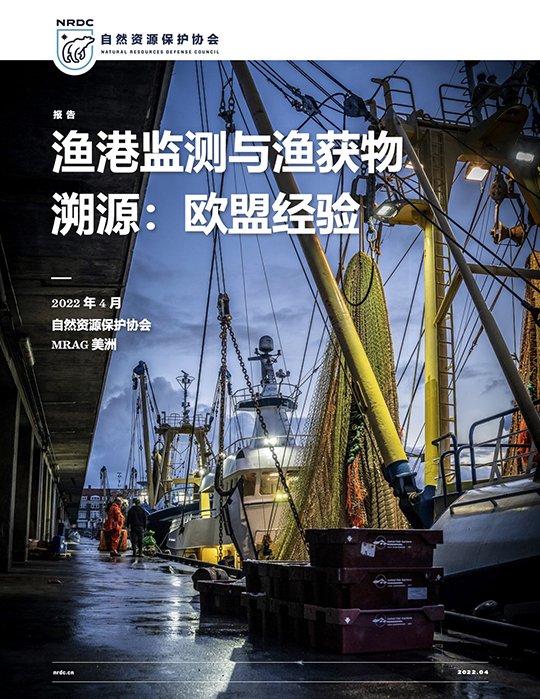
“依渔管港”的背景
落实渔业资源总量管理制度是我国为保护和恢复近海渔业资源、推进海洋渔业可持续发展、促进生态文明建设最重要的改革创新之一。
中央、省级和地方渔业主管部门从“十三五“开始对渔业资源总量管理制度的实现路径进行了积极的探索,并确立了渔港是其中的重要环节:作为渔业活动水域和陆域的交界点,渔港在防止非法渔获物上岸、收集渔获量数据、建立渔获物可追溯体系具有关口作用,能够为渔业产出管理提供直接的支撑。
如何根据我国渔业特点,借鉴国际经验,建设以渔港为核心的监督、控制和检查 (MCS)体系?
在依港管渔方面,欧盟是一个较好的研究对象。作为全球最大的海产品进口地区,近些年欧盟高度重视对非法、不报告和不管制(IUU)捕捞的治理。目前,欧盟是全球少数要求水产品全供应链可追溯的区域之一,所有在其水域内上岸的渔获物和养殖产品,无论是以食用还是饲料为目的,均需进行全供应链可追溯。此外,欧盟内部渔业类型多样化、小型渔船占比高、多渔种渔业突出、成员国管控制度和能力差异大,实施策略需兼顾标准化和灵活性,并依赖成员国与欧盟之间有效的协调。
考虑到欧盟与我国在渔业特点和面临的挑战等方面具有相似性,欧盟经验可提供一定的借鉴。
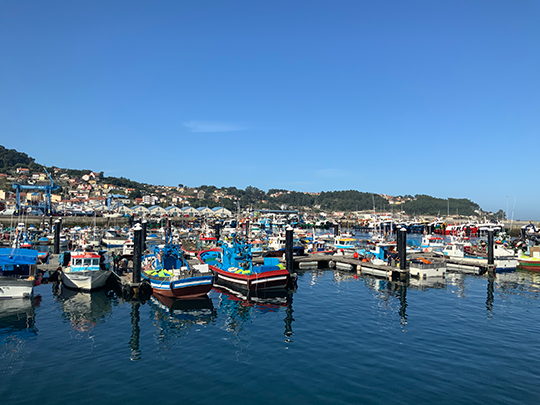 西班牙小型渔船(<12米)占全国渔船约73% @李薇
西班牙小型渔船(<12米)占全国渔船约73% @李薇
欧盟依港管渔的制度特点
渔港是欧盟用来阻止IUU渔获物上岸、保障海产品合法性的第一道防线,是收集上岸量数据的关键节点和可追溯体系的起点。
总体而言,欧盟通过法律规定细分了渔获物上岸前和上岸后的各个阶段,并对各阶段的管控及报告文件进行了统一的规定,同时考虑了大小渔船的差异。在实际操作中,欧盟渔业控制局通过实地检查、远程监控和专家意见来评估成员国的执行情况,并通过能力建设和资金激励努力减少成员国间的水平差距。欧盟通过信息化系统极大提升了依港管渔体系的整体效率。
具体而言,欧盟的依港管渔体系有以下三大特点:
1. 环环相扣的港口控制措施:
(1)在上岸前用电子日志进行提前通报。渔船进港提前通报可以给主管部门充分的时间判断是否对相关渔船进行检查,以及调配必要的资源和人力。根据欧盟的规定,所有从事商业捕捞且总长度为12米以上的渔船进港前都需要提前4小时通报。小型渔船一般不用提前通报。
如果渔获物量大或对特定品种(如蓝鳍金枪鱼),部分港口可能无法确保自身能力是否能完成检查工作,主管部门可对装载这些渔获物渔船的上岸港口以及港口开放时间和具体位置进行指定。欧盟禁止海上转运,转运只能在指定港口进行。指定港口通常是那些规模较大、设备更齐全、检查人员配备更多更专业的港口。在此基础上,指定港口还要考虑传统因素和经济因素,如靠近捕捞渔场或消费市场等。
(2)在上岸点进行称重,完成上岸申报。渔船离开港口后主管部门再收集渔获物数据将会加大难度,因此欧盟规定,渔获物必须在港口内使用经过认证的秤进行称重,并由此完成上岸申报、运输文件、销售单等。上岸申报中的数据非常重要,是成员国履行欧盟《数据收集框架》、开展资源评估以及实施包括限额捕捞(TAC)在内重要管理制度的关键信息。如果收集小于10米渔船的上岸量数据,一般采用抽样或基于销售单据。
以上是欧盟区域的统一要求。成员国如果想对这些措施进行调整,比如对大渔船采取抽样统计或允许在船上称重等,都需要获得欧盟的批准及监督。爱尔兰曾经允许渔获物运输后再称重,但经欧盟审计后发现存在秤作假等问题,导致该调整被撤销。
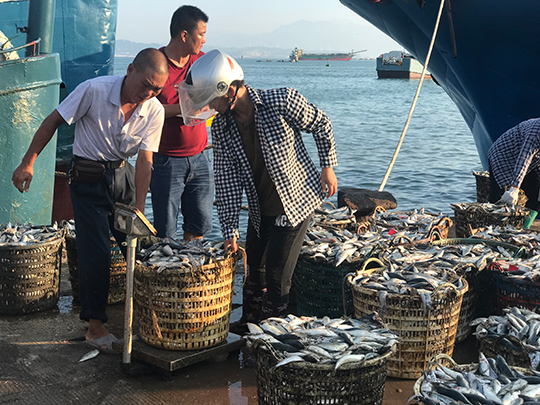 我国渔民在港口对渔获物进行称重,主要是自发的经营行为。我国尚无对渔港数据收集的法律规定。@李薇
我国渔民在港口对渔获物进行称重,主要是自发的经营行为。我国尚无对渔港数据收集的法律规定。@李薇
(3)只能通过港口拍卖场或者注册买家进行首次销售。拍卖场的优势在于为核实进入供应链的渔获物、管控首次销售这个关键的可追溯环节提供了一个集中的场所。拍卖场名单由官方认证并公布。
在拍卖前,拍卖场的工作人员需要将拍卖的渔获物种类和数量与渔船日志数据进行比较。这些工作人员要对渔获物进行称量并对数据的准确性负责,加贴可追溯标签,整理首次销售的相关信息并将其发送给主管部门。因此,虽然拍卖场的工作人员不是执法人员,但仍能起到一定的监督作用。负责经营拍卖场事务的第三方组织因地而异,可能是葡萄牙的国企,或意大利常见的地方协会、合作社、生产组织,甚至是港口部门自营。
拍卖场也给执法人员提供了一个较为集中的检查场所,国家和区域渔业主管部门、港口警察、国民警卫队,以及欧盟检察员进行定期或非定期的抽查。
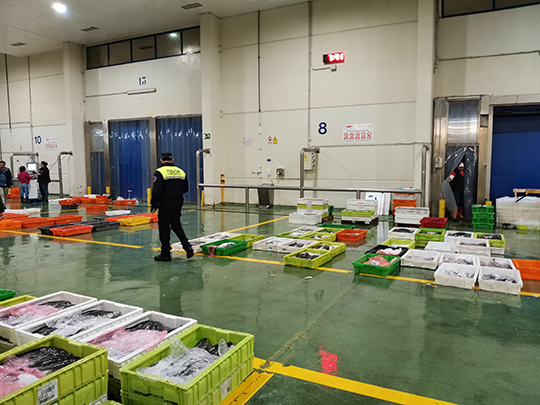 西班牙维戈渔港拍卖场内,港口警察对渔获物进行巡查@李薇
西班牙维戈渔港拍卖场内,港口警察对渔获物进行巡查@李薇
(4)实现可追溯的批次编号和关键信息
全供应链的可追溯具有多重意义,除了保障食品安全和防止海鲜欺诈(seafood fraud)外,可追溯还是阻止IUU渔获物进入供应链、保障海产品合法性的第二道防线。小型渔船的渔获物也要被纳入可追溯体系。小于合法尺寸的幼鱼但属于根据欧盟“丢弃禁令”必须上岸的鱼种也适用于可追溯规定。“丢弃禁令”亦称上岸义务。为避免渔民随意丢弃死鱼,浪费有价值的资源并影响环境。禁令规定,只要捕捞到受限额捕捞和合法尺寸管理的鱼种,就必须上岸并统计,以便在配额中扣除。
渔获物上岸时将被划分为称作“批次”的单元,即可追溯的单元。每个单元的渔获物可以是任意数量,只要来自同一船只/组和捕捞海域,属于同样的物种,并呈现同样的状态(去头去尾、去内脏处理等)即可。批次在上岸称重时生成编号,跟随批次编号一同录入系统的还有欧盟要求的关键信息(比如批次编号、鱼种商业名和科学名、使用的捕捞渔具、捕捞海域、净重等)。随渔获物流通的销售单、运输文件、商业发票等文件以及二维码和条形码都会含有该批次编号。批次编号能够帮助主管部门了解海产品与特定渔船捕捞事件之间的关系。
可追溯标签是有效的可追溯工具。首次销售环节的标签会较完整地显示批次信息并随渔获物一起流通。欧盟也规定了面向消费者的标签所需展示的最基本信息。在首次销售与终端零售之间,渔获物可能经过分割、合并、加工等处理。成员国可允许处于销售链条中间的经营者采取较灵活的可追溯方式,只要保证能追溯到该批次编号。目前,条形码和二维码已被欧盟成员国广泛使用。
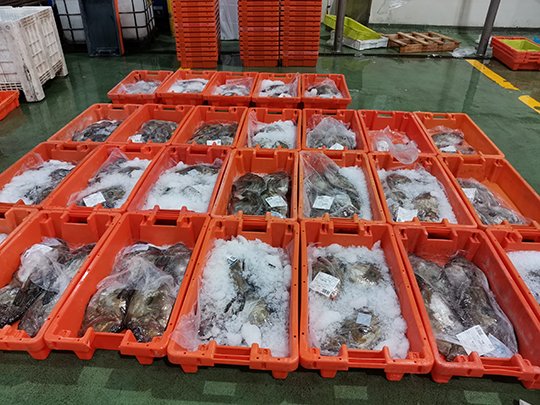 在拍卖场进行首次销售的渔获物,每个托盘都有相应的渔获物信息,首次销售的渔获物信息是可追溯的源头,将会伴随渔获物的销售和流转 @李薇
在拍卖场进行首次销售的渔获物,每个托盘都有相应的渔获物信息,首次销售的渔获物信息是可追溯的源头,将会伴随渔获物的销售和流转 @李薇
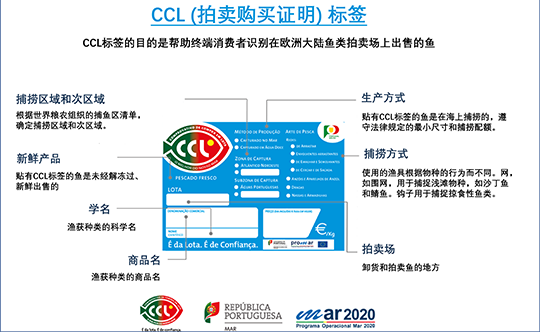 葡萄牙政府推广的面向消费者的可追溯标签,以及标签上的信息。@Docapesca
葡萄牙政府推广的面向消费者的可追溯标签,以及标签上的信息。@Docapesca
2. 基于风险评估、以创造公平环境为目的的执法体系
在港口码头,渔业执法人员对上岸渔船进行抽查。成员国一般在年度执法计划中(按港口/月份)设定基准检查率(如爱尔兰将本国渔船的检查率定为5%左右),并通过各种风险评估方法对IUU风险高的渔船进行筛选,提高渔港检查效率和精准度,但也可以随机抽查。
欧盟为渔船抵港、上岸和首次销售前制定了包括渔船身份、捕捞日志、配额使用、渔具等合规项目在内的检查清单,成员国可以在此清单的基础上增添检查项目。
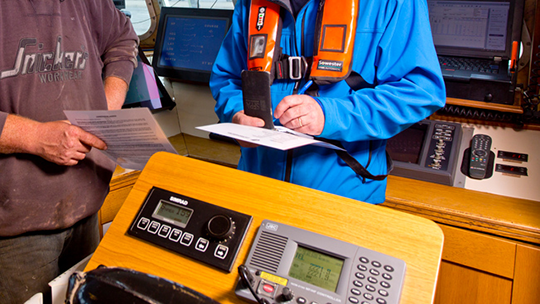 爱尔兰海洋渔业保护局的执法人员在港口检查船位监控系统(VMS)记录情况 @爱尔兰海洋渔业保护局
爱尔兰海洋渔业保护局的执法人员在港口检查船位监控系统(VMS)记录情况 @爱尔兰海洋渔业保护局
为确保整个欧盟地区的监测和监督处于同等水平,欧盟要求在各港口对渔船开展相似频次的检查,要求执行统一的流程和检查清单,最终目的是创造一个公平的市场环境。欧盟渔业控制局监控检查率和违法的处理情况,也会对各个港口上岸船只的数量进行监控。如果某个港口上岸的渔船数量骤增,可能是该港口监管不力的体现。
目前,所有成员国都建立了电子执法数据库,监督检查数据格式也是标准化的,有利于欧盟进行远程监控和比较。考虑到成员国检查人员的能力参差不齐,欧盟通过多种方式加强能力建设,包括提供培训、加强交流合作和最佳实践分享等。
渔获物上岸过程中的检查由渔业主管部门负责。上岸后,包括首次销售、运输、加工流通、零售等阶段,因各自的情况不同,各成员国执法检查的参与部门不尽相同。渔业、食品、环境、海关等部门以及各级主管机构都可能参与执法。
3. 强大的信息化支撑
欧盟近几年的渔业管控进步明显,这在很大程度归功于信息化体系的推广,其中最重要的是电子日志的推广。即使是无法安装电子日志的小型渔船,也大多在港口将纸质日志的数据输入电子系统。电子日志的优势,可参见NRDC另一份研究报告《渔业数字化报告》。
另外,在成员国共用欧盟水域的情况下,一个成员国的渔船在另一个成员国的港口上岸比较常见。由于日志、渔获证书以及检查数据在成员国之间通过电子方式实现信息共享,加上检查数据格式的标准化,相关机构能快速获得必要的信息。
电子化也大大提升了溯源的效果和效率,减少人为因素对信息质量的干扰,排除了同一渔获合法文件被重复使用的可能性。如果没有高效的信息化支撑,欧盟就很难实现对所有渔获物进行有效的可追溯。
借鉴欧盟经验
在2017年农业农村部发布《关于进一步加强国内渔船管控 实施海洋渔业资源总量管理的通知》后,我国已积极开展大中型渔船的定点渔港部署,建立了全国进出港报告制度,加强了VMS的落实,并在浙江省台州等地开展了渔船渔港综合管理改革国家试点,探索了与之配套的协助渔获追溯的绿色标签管理,部分内容也被写入修订中的《渔业法》草案。
根据上述欧盟“依港管渔”制度三大特点和相关经验,在“十四五”阶段,报告提出以下建议:
(1)在管控措施方面,地方渔业主管部门继续在定点渔港进行试点,探索如何将进出港报告、VMS、电子日志等控制措施进行协调组合,以支撑渔获物数据收集和限额捕捞体系,并与国家渔业主管部门积极沟通,探讨制定统一的标准。
其中,为了实现对渔获物数据较为全面的收集和核验,并与渔政执法人员的抽查制度形成补充,应充分挖掘和发挥研究机构、高校、技术推广机构等单位以及各级渔业组织在其中的作用。
(2)在执法遵约方面,大力加强对渔政队伍建设的重视和支持力度,积极开展能力建设,提升执法人员在渔港执法方面的理论知识和实践技能,实现相对均等的港口监管水平。
(3)在提高效率和加强协调方面,充分利用我国信息技术快速发展的条件,在渔业监测、监督和执法、数据管理等中引入电子日志/证书、卫星跟踪技术、智能称重设备、二维码/条形码等一系列新型科技工具。
